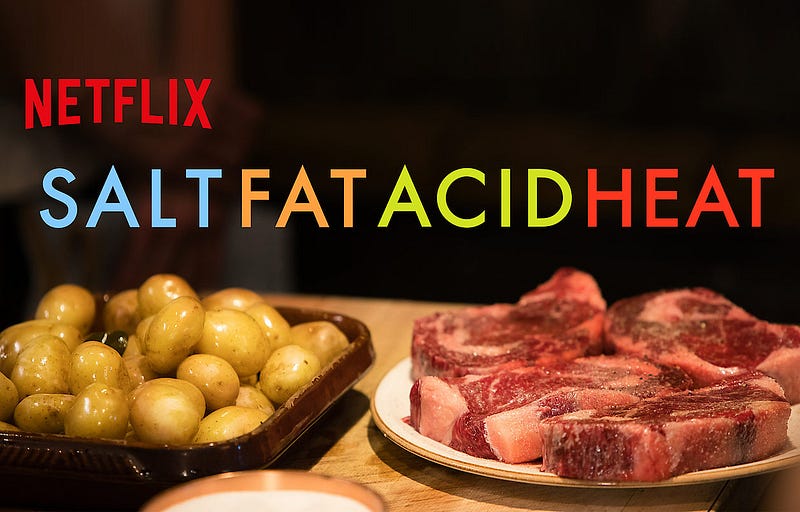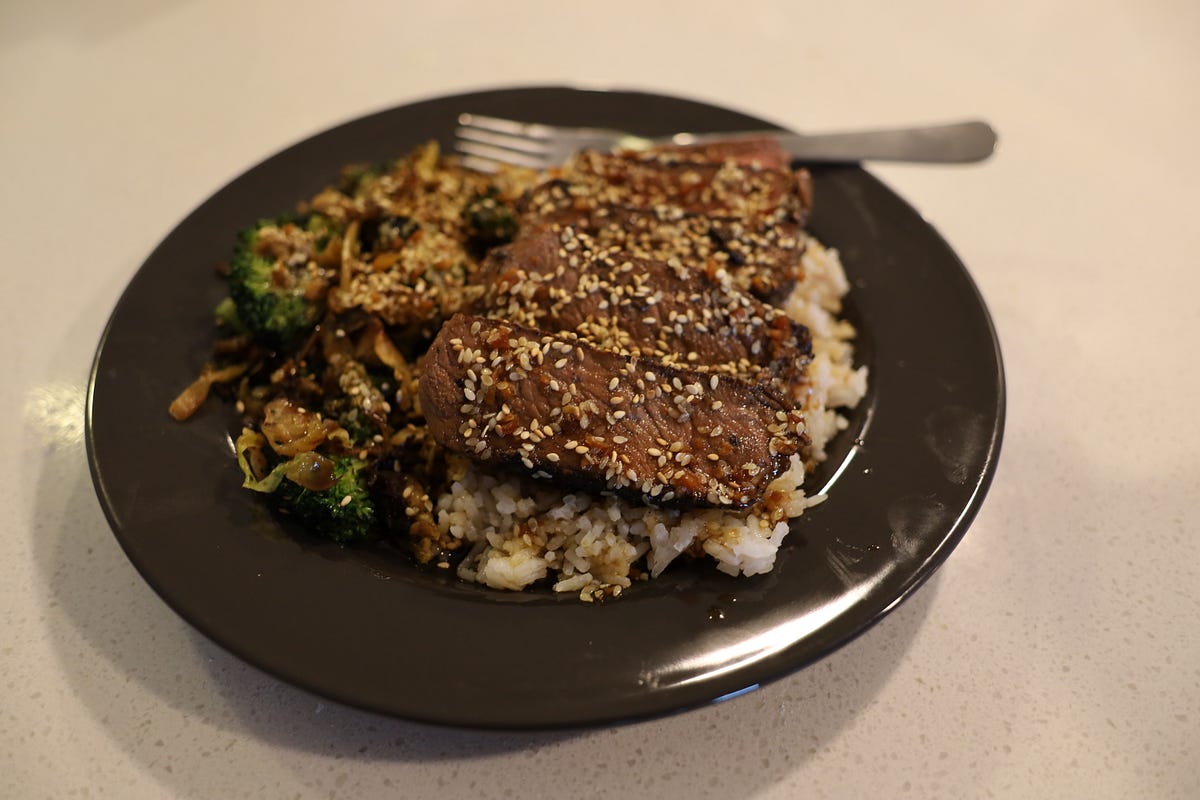5 Practical Tips That Will Make You Want To Cook at Home
Make your food taste more like the restaurant food you love without spending a decade making a meal.
We all know that cooking your own food at home is one of the best ways to eat healthier and save money. But when you’re new to cooking, making food that you actually want to eat can be challenging, and when it takes you 2 hours to make a meal that’s half as good as your favorite take-out spot down the street, it’s no wonder that take-out meal is so enticing.
But what if your homemade food looked like this?
Pasta carbonara with bacon, mushrooms, and lots of yummy freshly shredded cheeses. And a side of roasted broccoli cause health.
Okay, pasta carbonara may not be the most healthy dish to make, but if making something like pasta carbonara gets you excited to be in the kitchen whipping up your own food, that’s miles better than getting take-out every night. Plus, I bet my pasta carbonara is at least a little healthier than what I would get at a restaurant.
Without further ado, here are 5 simple and practical things that have made me a better home chef.
1. Utilize food from your favorite restaurants, *especially their sauces*.
This may seem counter to the thesis of this article, but you don’t need to make everything from scratch to be a good home cook. In fact, there’s a different kind of art to being able to revive restaurant leftovers or utilize other ingredients and expanding them into a full meal.

The fries were from restaurant leftovers and the BBQ sauce from a different restaurant.
When you go to a restaurant, there’s a reason you love their food, so why not utilize it in your own cooking. In particular, 99/100 times, the thing that makes that restaurant’s food so good is their sauce, and it never hurts to ask if you can get some of their sauce, or even pay for a larger container to go.
In time, as you gain confidence, you can attempt to re-create those sauces yourself to save money and maybe make them a bit healthier too. For instance, I made my own teriyaki sauce recently from scratch which was super delicious and healthier than what you’d find at a restaurant!
Aside from sauces, another good route to go is to get some of your favorite restaurants’ component foods they use in their meals. Go for something you can incorporate into something else: slaws, roasted veggies, marinated meats, side dishes, etc. You can use these to build off of to make your own meals. Again, this is an art form that you’ll get better at over time.
Here are some hypothetical examples:
You love the Korean steak tacos from a local family restaurant. The next time you go, you ask if you can get some of their gochujang aioli they use on those tacos that makes them so damn good (or get some of their kimchi to go). Then you can make your own marinated meat or veggies and make your own tacos, or use the aioli on a protein bowl, or maybe on a sandwich. You get the idea.
There’s a local sandwich shop that has a killer Reuben sandwich with a special coleslaw mix they make from scratch. Next time you go, ask if you can buy a large side of the slaw to take home. Then you can make your own Reuben with pastrami from the grocery store, or put it into some tacos, etc.
Your favorite BBQ spot has amazing pulled pork and you (like me) don’t have a smoker or the means to re-create it, so you buy some of that pork by itself and make stuff with it or simply make your own sides to create a classic BBQ plate meal.
You love a local restaurant’s roasted brussels sprouts appetizer. Get one to go next time and make your own main dish to go with it.
Buy your favorite restaurants’ salad dressings. These can be very versatile and will help you make great salads at home.

This isn’t using restaurant food per say, but the fermented slaw is from a brand called Olive My Pickle. It was a great sandwich too!
2. Dish lacking flavor? You probably need more salt or acid.
There’s a book called Salt, Fat, Acid, Heat (not an affiliate link) which postulates that the foundations of flavor comes down to those four elements. When making food at home, usually if the dish just isn’t hitting right, it’s because it’s lacking one of these ingredients, and for rookie chefs, salt and acid are the most likely culprits.

Oh yea, and it’s also a Netflix show now.
I’ve seen this trend play out in my own cooking. Often when the flavor of my dish is lacking, it’s because I need to add more acid or salt (or sometimes it’s because I’ve added too much salt and need to balance it with more acid).
Try to keep some limes, lemons, oranges, grapefruits, and/or vinegars on hand to be able to add a dash of acid to whatever you’re cooking. You’d be surprised how much of a difference a half a lime can make.
And sometimes all you need is a dash of salt.
3. Build a wide array of staples.
One of the most important things I’ve learned about cooking is that it’s really useful to become good at a few staple kinds of dishes. These form a reliable back-bone to your cooking arsenal that you can confidently rely on any time. My staples, for example, are:
Tacos. BBQ tacos, fajita tacos, Indian tacos, etc, etc, etc. Tacos are so versatile, and learning how to balance 2–4 flavors against each other to make a great taco will take you far and make you a better chef. Bonus points if you make your own tortillas.
Pasta. I love pasta, and one of the biggest reasons I love it is because pasta is so flexible. I’ve made traditional Italian pastas, Indian-infused pastas, Asian-flavored noodles, and more. Again, learning how to balance a few key flavors is all it takes to make great pasta.
Sandwiches. This is basically the same as tacos but with a different bread. Almost anything you would make as a taco would also be good as a sandwich. Bonus points if you make your own bread. I also make a mean burger which I count as a type of sandwich.
Rice bowls. Sub out rice for quinoa, couscous, etc if you like, but a good rice bowl with protein and veggies is a reliably healthy and tasty meal.
Indian food. I’m half Indian (as you might have guessed given my name), and my mom (ironically the non-Indian parent) taught me the basics of making good Indian food and furnished me with a great array of staple Indian spices. I can now cook this kind of food or infuse these kinds of flavors in other foods whenever I want. You could apply this with your own cultural food heritage too.
There are plenty of other kinds of staple foods you could add to your arsenal. Follow your heart and the kinds of foods you typically gravitate towards naturally. For instance, if you love tacos and learn how to make killer tacos, it will do wonders for your confidence in the kitchen (have I talked about tacos enough haha)!

A wonderful teriyaki steak I made recently with the sauce I mentioned earlier. A great example of a healthy rice bowl that’s delicious,
4. Print out your recipes.
This one is more self-explanatory. Trust me. Printed recipes are 100x easier to follow than looking them up on your phone. Being able to mark off completed steps and see everything at a glance will save you a surprising amount of time, and you will be much more likely to end up with a faithful attempt at the recipe rather than disappointment. Just do it, please.
5. It’s okay to start with meal kits.
Meal kit companies like Hello Fresh, Blue Apron, Home Chef, etc are all pretty decent meals. In my experience, the portion sizes tend to be on the small side (so you may want to up the portions), but just the recipe cards you get are worth the price of a few boxes. And you can always get additional groceries to add to these to bulk them up (or to infuse some of your own flavors/ingredients into the mix).
I wouldn’t use them for long, however, as they are far pricier than getting your own groceries (and you get less food with them), but if you churn out promos, you can build up a little recipe book to help with putting meals together. Particularly, I’ve found that these meal kit services often have good sauces which as I mentioned before, often make good meals.
Just make sure you don’t just re-create these recipes after the fact. Use them as a creative base from which to innovate your own culinary creations.

As you can see, I churned quite a few promos for these services…
Bonus Tip: If you mess something up, it’s okay to not eat it.
This is from a recent personal experience. I tried to make a balsamic glaze sauce using balsamic vinegar, jam, and bouillon as the base flavors. Thing is, I added too much bouillon, and it basically ruined it. No amount of extra jam, vinegar, or lime was cutting it. In the end, I used a bit of the sauce for the meal I made it for (and it was okay, definitely not great), but I ended up throwing the rest away after a few days had passed and I just had no desire to use it anymore.
If you made something, and you just don’t want to eat it or don’t want to eat it a second time after a few days, it’s okay to throw it out and try something else. Or just get take-out tonight and try cooking again tomorrow. We’re human after all.
Finally, just start cooking.
And take it slow. Instead of jumping into the deep end with a super complicated recipe, build on your skills. Start small and keep trying more and more complicated recipes over time. Find ways to mix and match recipes, or use a part of one recipe and make something else to go with it. Before you know it, you’ll have enough confidence to take on some kitchen challenges that are currently intimidating to you. And the real learning is going to come when you try to make something original or mix and match recipes. Cooking can be a very creative pursuit if you want it to be.
If you enjoyed reading this, I’d really appreciate a follow here on Medium. I write about things like crypto and popular media, but I’m also trying to write more about cooking and other personal explorations and discoveries. I’d love to have you on this journey.
Till next time!

